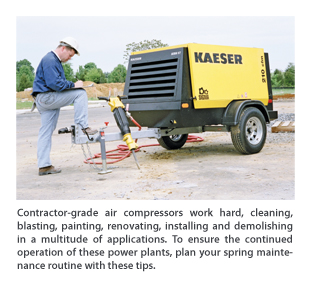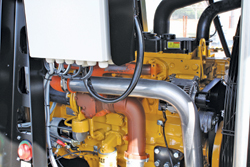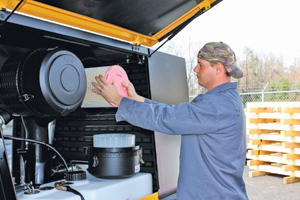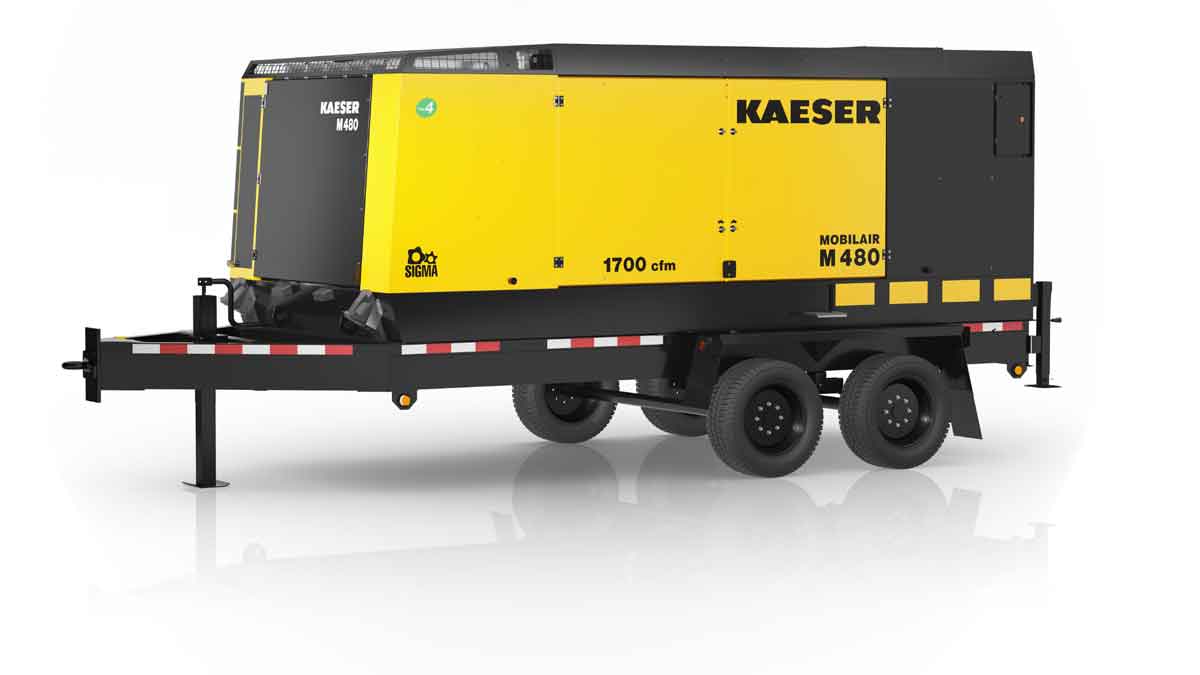Air Supply
Harness the power of air. With a portable air compressor, contractors can channel pressurized gases to drive their tools and crews into ever new applications (hammers, vacuums, nail guns, pumps and other new jobs).

It’s just not worth the risk. If you don’t currently have a preventive maintenance agreement for your compressors, in-house personnel can be trained to handle these functions. The following general maintenance checklist outlines the basics of compressor maintenance, which should be performed according to the recommended intervals.
Finally, don’t make the mistake of thinking that an annual service checkup will cover it. Rather, check the engine oil, coolant and fuel levels daily in addition to inspecting air intake contamination alarms and the fuel water separator.
Maintenance Checklist
1. Pump or Airend — the unit’s compression mechanism. While there are several methods, most portable
units in today’s market use a rotary screw airend.
Rotary Screw Airend — compresses air internally using two helical lobe rotors inside a housing.
A. Check for mechanical seal leakage.
B. Check for inlet valve wear.
C. Check for excessive bearing “play.”
D. Recommended rebuild: 50,000 to 100,000 hours.
2. Drive Train — mechanically connects the airend to the engine allowing the engine to drive the airend.
A. Direct Drive (without permanent alignment components) — engine and motor are directly connected.
a. Verify that the direct drive system is perfectly aligned.
b. Check frame and mounting block for “settling” which may cause misalignment and coupling damage.
B. Direct Drive (with permanent alignment components) — engine and motor are directly connected with a maintenance-free coupling for “zero-loss” transmission efficiency. This relatively new concept is available only from some manufacturers.
a. Check coupling annually.
C. Gear Drive — a system of gears used to connect the airend and engine.
a. Check spray bar for excessive contaminants and plugged orifices.
b. Check for wear and “backlash” or excessive play between the gears.
c. Ensure proper lubrication.
D. V-Belts Drive — a system of belts and pulleys that connect the airend and motor. Only occasionally found in portable units.
a. Check V-belt tension — V-belts should be taut — but not over tightened — with very little slack or play.
b. Check wear on V-belt/pulley.

A. Check engine lubricant level.
B. Check air intake filter contamination alarm.
C. Clean and replace air intake filter regularly.
D. Adjust valve clearance.
E. Check and adjust engine fan belt tension.
F. Inspect the fuel injectors.
G. Recommended engine lubricant change interval: 500 hours.
H. Recommended engine lubricant filter change interval: 500 hours.
4. Chassis — the frame and housing for compressor components. It also includes canopy, tow bar, tires, bumpers and a solid steel flooring from some manufacturers.
A. Check tire pressure and inspect for excessive tread wear.
B. Tighten wheel bolts if necessary.
C. Grease coupling head, joints and tow bar.
5. Lubricants — lubricants in the airend cool, seal, lubricate and remove contaminants.
A. Use proper grade (see manufacturer’s manual).
B. Drain existing lubricant before refilling.
C. Draw lubricant samples at regular intervals to determine maximum lubricant life.
D. Use synthetic lubricant for maximum service life.

A. Compressor Air Filter — generally located prior to the airend inlet valve and removes bulk contaminants from the air entering the airend. Any contaminants not trapped in the filter will eventually damage machinery and equipment.
a. Use proper micron rating as specified by OEM.
b. Check pressure differential and, if necessary, carefully clean according to manufacturer’s recommendations.
c. Check for worn/damaged seals.
d. Check structural integrity.
e. Recommended air filter change interval: 500 hours.
B. Lubricant Filter and Lubricant Separator — the compressor lubricant filter removes particulates from the lubricant circulated in the airend. The lubricant separator removes lubricant from the air before it is discharged.
a. Check the lubricant level and change regularly.
b. Replace compressor lubricant filter.
c. Change the lubricant separator cartridge in the lubricant separator.
d. Clean the lubricant cooler.
e. Use only genuine replacement parts.
f. Caution: Do not change filters or check fluids while the compressor is running. Spraying fluids such as oil can cause burns or serious injury.
g. Recommended lubricant change interval: 1,000 hours.
h. Recommended compressor lubricant filter change interval: 1,000 hours.
i. Recommended lubricant separator cartridge change interval: 2 years or 1,000 hours.
7. Radiator — provides cooling for the engine and in some cases will provide compressor fluid cooling.
A. Check the engine coolant level.
B. Check for visible contamination and clean regularly.
C. Check the anti-freeze protection and change coolant if necessary.
D. Inspect hoses and hose clamps for wear.

A. Check the battery’s electrolyte and pole connections.
B. Check the lifting frame.
C. Check hoses for wear and tightness.
D. Check all accessible screw connections, pipelines and clamps for wear and tightness.
E. Grease the canopy hinges.
F. Ensure that pressure and temperature gauges are working.
Once service is complete double check that all protective guards and cover panels have been properly re-installed and that all tools have been removed from the compressor unit. Routine maintenance also helps ensure the compressor’s safe operation on site as well. Never compromise operator safety by delaying required maintenance. In addition, advise users on the proper safety gear for the intended application. Provide a mini-instruction course and safety pamphlet on safe compressor operation. Review all precautions with regular users as well.
Chance Chartters is a direct accounts manager at Mobilair for Kaeser Compressors Inc., based in Fredericksburg, Va.






Comments are closed here.